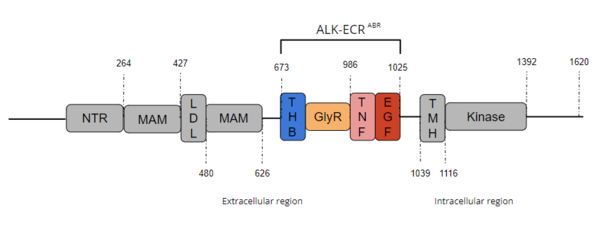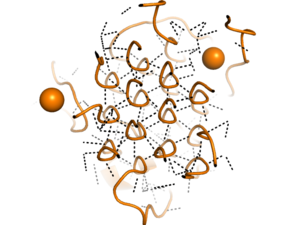Sandbox Reserved 1726
From Proteopedia
(Difference between revisions)
| Line 35: | Line 35: | ||
== Inhibition, Regulation, and Future Pathways == | == Inhibition, Regulation, and Future Pathways == | ||
| - | The regulation of ALK dimerization by ALKAL points to one clear way of inhibiting ALK activity and may offer new therapeutic strategies in multiple disease settings <ref name="Li">PMID:34819665</ref>. As the dimerization of ALK is essential for activation of this protein, the inhibition of this activation is a potent way of inhibiting further ALK activity.<ref name ="Li" /> The inhibition and regulation of this extracellular region of ALK is actively being explored, as this part of ALK is part of what distinguishes it from other RTKs, like LTK. Researchers are currently exploring the use of [https://proteopedia.org/wiki/index.php/Antibody antibodies] as a means of inhibiting the activity of ALK through the extracellular domain. | + | The regulation of ALK dimerization by ALKAL points to one clear way of inhibiting ALK activity and may offer new therapeutic strategies in multiple disease settings <ref name="Li">PMID:34819665</ref>. As the dimerization of ALK is essential for activation of this protein, the inhibition of this activation is a potent way of inhibiting further ALK activity.<ref name ="Li" /> The inhibition and regulation of this extracellular region of ALK is actively being explored, as this part of ALK is part of what distinguishes it from other RTKs, like LTK. Researchers are currently exploring the use of [https://proteopedia.org/wiki/index.php/Antibody antibodies] and more specifically [https://proteopedia.org/wiki/index.php/Monoclonal_Antibody#:~:text=Monoclonal%20antibodies%20are%20immunoglobulins%20produced,pure%20homogeneous%20type%20of%20antibody. monoclonal antibodies]<ref name="Carpenter">PMID: 22266870</ref> as a means of inhibiting the activity of ALK through the extracellular domain. It is hypothesized that these monoclonal antibodies act by binding to the binding site of ALK, thus preventing ALKAL from binding<ref name="Li">, and thus induces cytotoxicity to the cancerous cell itself.<ref name ="Carpenter"> |
ALK can also be regulated in the extracellular domains by its own ligands. The different qualities of ALKAL1 and ALKAL2 make them both unique ligands for ALK, and both have different qualities in their interactions with ALK. | ALK can also be regulated in the extracellular domains by its own ligands. The different qualities of ALKAL1 and ALKAL2 make them both unique ligands for ALK, and both have different qualities in their interactions with ALK. | ||
</StructureSection>. | </StructureSection>. | ||
== References == | == References == | ||
<references/> | <references/> | ||
Revision as of 20:51, 20 April 2022
| This Sandbox is Reserved from February 28 through September 1, 2022 for use in the course CH462 Biochemistry II taught by R. Jeremy Johnson at the Butler University, Indianapolis, USA. This reservation includes Sandbox Reserved 1700 through Sandbox Reserved 1729. |
To get started:
More help: Help:Editing |
Anaplastic Lymphoma Kinase Extracellular Region
| |||||||||||
References
- ↑ 1.00 1.01 1.02 1.03 1.04 1.05 1.06 1.07 1.08 1.09 1.10 Huang H. Anaplastic Lymphoma Kinase (ALK) Receptor Tyrosine Kinase: A Catalytic Receptor with Many Faces. Int J Mol Sci. 2018 Nov 2;19(11). pii: ijms19113448. doi: 10.3390/ijms19113448. PMID:30400214 doi:http://dx.doi.org/10.3390/ijms19113448
- ↑ 2.00 2.01 2.02 2.03 2.04 2.05 2.06 2.07 2.08 2.09 2.10 2.11 2.12 2.13 2.14 2.15 2.16 2.17 2.18 2.19 Reshetnyak AV, Rossi P, Myasnikov AG, Sowaileh M, Mohanty J, Nourse A, Miller DJ, Lax I, Schlessinger J, Kalodimos CG. Mechanism for the activation of the anaplastic lymphoma kinase receptor. Nature. 2021 Dec;600(7887):153-157. doi: 10.1038/s41586-021-04140-8. Epub 2021, Nov 24. PMID:34819673 doi:http://dx.doi.org/10.1038/s41586-021-04140-8
- ↑ 3.0 3.1 3.2 3.3 Borenas M, Umapathy G, Lai WY, Lind DE, Witek B, Guan J, Mendoza-Garcia P, Masudi T, Claeys A, Chuang TP, El Wakil A, Arefin B, Fransson S, Koster J, Johansson M, Gaarder J, Van den Eynden J, Hallberg B, Palmer RH. ALK ligand ALKAL2 potentiates MYCN-driven neuroblastoma in the absence of ALK mutation. EMBO J. 2021 Feb 1;40(3):e105784. doi: 10.15252/embj.2020105784. Epub 2021 Jan 7. PMID:33411331 doi:http://dx.doi.org/10.15252/embj.2020105784
- ↑ 4.0 4.1 4.2 4.3 Li T, Stayrook SE, Tsutsui Y, Zhang J, Wang Y, Li H, Proffitt A, Krimmer SG, Ahmed M, Belliveau O, Walker IX, Mudumbi KC, Suzuki Y, Lax I, Alvarado D, Lemmon MA, Schlessinger J, Klein DE. Structural basis for ligand reception by anaplastic lymphoma kinase. Nature. 2021 Dec;600(7887):148-152. doi: 10.1038/s41586-021-04141-7. Epub 2021, Nov 24. PMID:34819665 doi:http://dx.doi.org/10.1038/s41586-021-04141-7
- ↑ 5.0 5.1 Della Corte CM, Viscardi G, Di Liello R, Fasano M, Martinelli E, Troiani T, Ciardiello F, Morgillo F. Role and targeting of anaplastic lymphoma kinase in cancer. Mol Cancer. 2018 Feb 19;17(1):30. doi: 10.1186/s12943-018-0776-2. PMID:29455642 doi:http://dx.doi.org/10.1186/s12943-018-0776-2
- ↑ Carpenter EL, Haglund EA, Mace EM, Deng D, Martinez D, Wood AC, Chow AK, Weiser DA, Belcastro LT, Winter C, Bresler SC, Vigny M, Mazot P, Asgharzadeh S, Seeger RC, Zhao H, Guo R, Christensen JG, Orange JS, Pawel BR, Lemmon MA, Mosse YP. Antibody targeting of anaplastic lymphoma kinase induces cytotoxicity of human neuroblastoma. Oncogene. 2012 Nov 15;31(46):4859-67. doi: 10.1038/onc.2011.647. Epub 2012 Jan, 23. PMID:22266870 doi:http://dx.doi.org/10.1038/onc.2011.647


